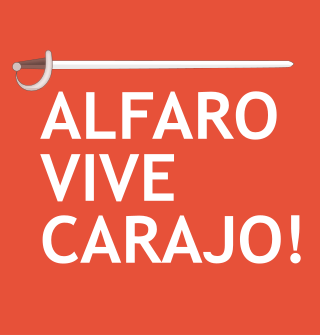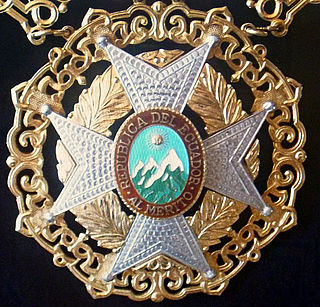
The Sucre was the currency of Ecuador between 1884 and 2000. Its ISO code was ECS and it was subdivided into 10 decimos and 100 centavos. The sucre was named after Latin American political leader Antonio José de Sucre. The currency was replaced by the United States dollar as a result of the 1998–99 financial crisis.

Manuel de Ascázubi y Matheu served as Vice President of Ecuador from 1847 to 1849 and in that capacity he was also interim President from 16 October 1849 to 10 June 1850.

Judith Gutiérrez Moscoso was an Ecuadorian painter who lived and worked in Ecuador and Mexico. Along with other female artists, she formed part of the Guayaquil School for Contemporary Plastic Arts and was active in militant groups such as the Union of the Women of Guayas, a precursor to Ecuadorian feminist organizations.

¡Alfaro Vive, Carajo! (AVC), another name for the Fuerzas Armadas Populares Eloy Alfaro, was a clandestine left-wing group in Ecuador, founded in 1982 and named after popular government leader and general Eloy Alfaro. The group was labeled as a terrorist organization for the Ecuadorian state during the period of the former president León Febres Cordero, existing between 1983 and 1991, years where they carried out various armed actions and criminal acts in Ecuador, with Colombian (M-19) and Nicaraguan influence. The group was initially formed sometime in the 1970s, but was not active militarily for the first few years of the 80's.

The Central University of Ecuador is a national university located in Quito, Ecuador. It is the oldest and largest university in the country, and one of the oldest universities in the Americas. The enrollment at the university is over 10,000 students per year.

The Central Bank of Ecuador is the central bank of the country, and an institution of the Executive Function, which has institutional, administrative, financial, and technical autonomy. It is in charge of executing the monetary policy established by the Monetary Policy and Regulation Board of Ecuador, which has been the institution's highest governing body since October 2021.

Mariana de la Noche is a Mexican telenovela produced by Salvador Mejía Alejandre for Televisa in 2003.
This article provides a historical summary of the currency used in Ecuador. The present currency of Ecuador is the United States dollar.

Bajo la misma piel is a Mexican telenovela produced by Carlos Moreno Laguillo for Televisa. It is an original telenovela from Martha Carrillo. It premiered on September 15, 2003 and ended on January 16, 2004. Despite huge exposure prior to its premiere, Bajo la misma piel was only a moderate success in its country of origin, Mexico, and was a virtual flop during its airing on Univision in the United States.

Gabriela Alejandra Rivadeneira Burbano is an Ecuadorian politician. She was President of the National Assembly of Ecuador between May 2013 and May 2017. Previously she was Governor of Imbabura Province from 2011 to 2012.

Part of Me is a Spanish-language telenovela produced by United States and México-based television network Telemundo Studios, Miami. It is based on the 2005 Telemundo telenovela El Cuerpo del Deseo, which in turn is based on the 1992 RTI Colombia telenovela En Cuerpo Ajeno. María Elisa Camargo and David Chocarro stars as the main protagonists, while Vanessa Villela and Jorge Luis Pila stars as the main antagonists, with the special participation of Laura Flores.

Peleles, also known as Pushovers, is a Chilean television soap opera created by Rodrigo Cuevas, that aired on Canal 13 from July 26, 2011, to January 15, 2012, starring Mario Horton, Claudio Arredondo, Daniel Alcaíno, Néstor Cantillana, and Cristián Campos.
El vuelo del águila is a Mexican telenovela produced by Ernesto Alonso and Carlos Sotomayor for Televisa in 1994–1995. Telenovela based on the Mexican soldier and President of Mexico Porfirio Díaz, from his name had come out the title "Época Porfiriana" or "Porfiriato" during the period of his rule, in the years 1876–1911.
Isabel María Josefina Robalino Bolle was a Spanish-born Ecuadorian lawyer and politician.

María de las Mercedes Jijón de Vivanco y Chiriboga was the first First Lady of Ecuador, serving in that capacity twice alongside her husband, Juan José Flores.

The National Order of Merit is a civil order granted by the President of Ecuador. The Order, which is the second highest among the decorations of Ecuador, was established on October 8, 1921, and promulgated in Registro Oficial No. 337 on October 27, 1921. It was later modified by Decree No. 37 on June 28, 1937, and by Decree No. 3109 on September 26, 2002.

The 2022 Copa CONMEBOL Libertadores Femenina was the 14th edition of the CONMEBOL Libertadores Femenina, South America's premier women's club football tournament organized by CONMEBOL. The tournament was held in Ecuador from 13 to 28 October 2022. Corinthians were the defending champions but they were eliminated in the quarter-finals.
The 2022 Campeonato Ecuatoriano de Fútbol Serie A, known as the LigaPro Betcris 2022 for sponsoring purposes, was the 64th season of the Serie A, Ecuador's top tier football league, and the fourth under the management of the Liga Profesional de Fútbol del Ecuador. The season began on 18 February and ended on 13 November 2022.














